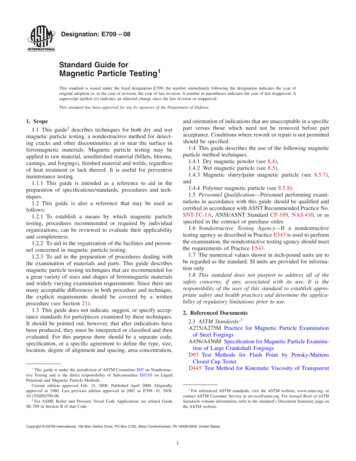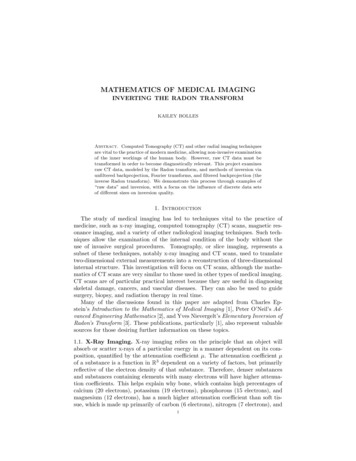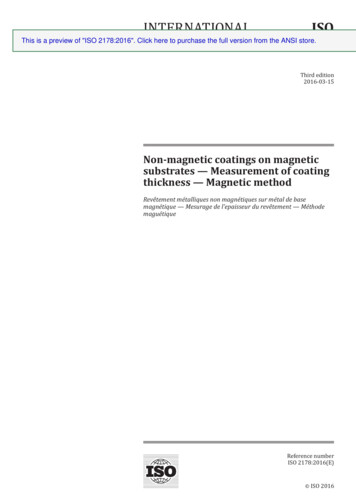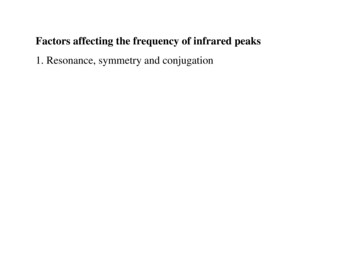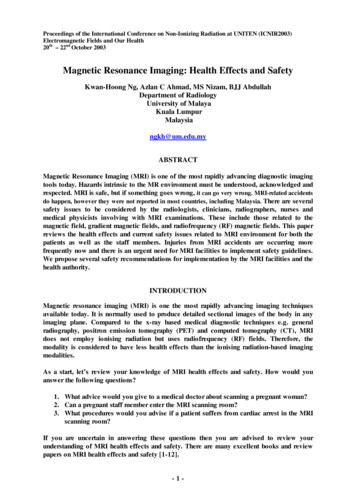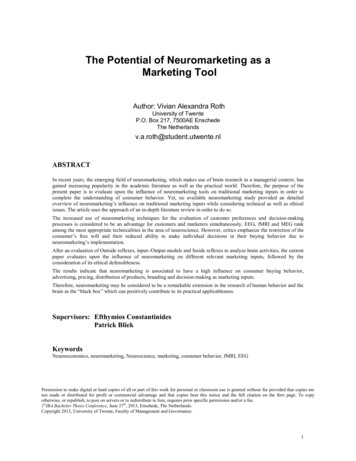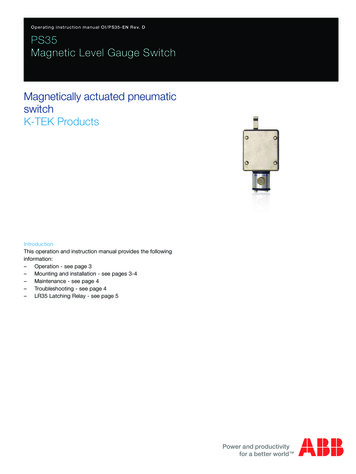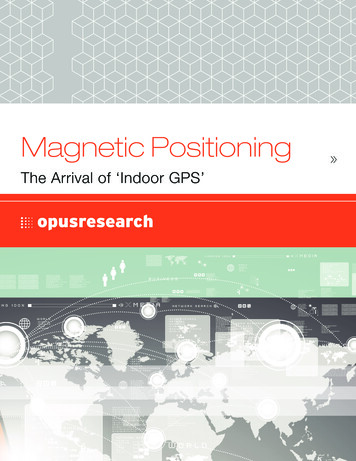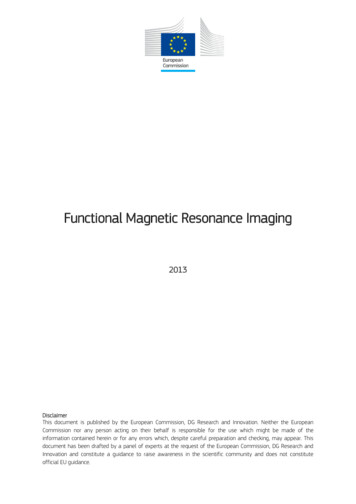
Transcription
Functional Magnetic Resonance Imaging2013DisclaimerThis document is published by the European Commission, DG Research and Innovation. Neither the EuropeanCommission nor any person acting on their behalf is responsible for the use which might be made of theinformation contained herein or for any errors which, despite careful preparation and checking, may appear. Thisdocument has been drafted by a panel of experts at the request of the European Commission, DG Research andInnovation and constitute a guidance to raise awareness in the scientific community and does not constituteofficial EU guidance.
Directorate General for Research and InnovationEthics SectorFunctional MagneticResonance ImagingUnderstanding the technique and addressingits ethical concerns with a future perspectiveEuropean Commission2013
Members of the Working PartyDaniela Seixas (Chair)Neuroradiology Consultant, Department of Imaging, Centro Hospitalar de Vila Nova deGaia/Espinho; Invited Assistant Professor, Department of Experimental Biology, Faculty ofMedicine, University of Porto, Portugaldseixas@med.up.ptGuy EbingerProfessor Emeritus of Neurology, Free University Brussels – VUB; former Head of Department ofNeurology University Hospital UZ Brussels, BelgiumJanet MifsudAssociate Professor, Department of Clinical Pharmacology and Therapeutics, Faculty ofMedicine and Surgery, University of Malta, Msida Malta MSD 2040janet.mifsud@um.edu.mtJoseph Schmucker von KochProfessor of Bioethics/Medical Ethics, Philosophical and Social Sciences Faculty, University ofRegensburg, Germany; Deputy Chairman of the Research Ethics Committee of the MedicalAuthorities in the State of Bavaria (Bayerische Landesaerztekammer), GermanySheri AlpertIndependent Scholar and Affiliate Investigator at Indiana University, Center for Bioethics, UnitedStates of Americai
AcknowledgmentsWe are indebted to those who provided invaluable comments on this document,including Sofia Brandão from São João Hospital, Paulo Branco from the Faculty ofMedicine of Porto University, and Joana Nunes from Centro Hospitalar de Vila Nova deGaia/Espinho.ii
“With the fMRI results in the very early nineties, MRI itself took on an entirely new direction.Rather than MRI providing only anatomic and some basic physiologic information, it now couldproduce dynamic brain activation maps quickly, non-invasively, and with relatively high resolution.Many MRI technicians, industry engineers, marketing people, radiologists, scientists and othersof the MRI establishment were nonplussed as researchers started having healthy volunteers, inthe name of brain activation, doing all kinds of odd things in the magnet other than simply lyingperfectly still with eyes closed — then producing highly processed and wildly colored mapsrather than the standard gray scale. A revolution had begun. We could now look into the humanbrain as never before — and we were leveraging mostly established technology to do it.”Peter A. Bandettini, fMRI pioneer, 2012iii
ForewordFunctional magnetic resonance imaging (fMRI) has revolutionized the study of thehuman brain functions in vivo. Due to the rapid implementation, particularly inneuroscience research, and complexity of this imaging method, its development anduse has not been always adequately supported by ethics. It was the aim of thisdocument to provide a reflective assessment of the ethical issues that are raised byfMRI and propose solutions, not separating this assessment from a sound backgroundon the history, functioning, limits, safety, applications and future of the technology.Daniela SeixasChair of the Working Partyiv
ObjectivesTo explain the functioning, risks and limits of the technique of functional magneticresonance imaging (fMRI), in the context of its history and future perspectives.To identify and consider the ethical issues that arise from the use of fMRI to study thehuman brain in clinical practice and in research, and in non-medical and non-researchsettings.To produce recommendations on ethics useful for research, policy, governance andpublic engagement.v
Abbreviation ListACR – American College of RadiologyAD – Alzheimer’s diseaseADNI – Alzheimer’s Disease Neuroimaging InitiativeBOLD – blood oxygenation level dependent contrastCPT – current procedural terminologyDBS – deep brain stimulationDMN – default mode networkEEG – electroencephalographyFDA – U.S. Food and Drug AdministrationfMRI – functional magnetic resonance imagingFMRIB – Oxford Centre for Functional Magnetic Resonance Imaging of the BrainIF – incidental findingsMEG – magnetoencephalographyMRI – magnetic resonance imagingNMR – nuclear magnetic resonancePET – positron emission tomographyphMRI – pharmacologic MRIRF – radiofrequencySAR – specific absorption rateSMF – static magnetic fieldSPECT – single-photon emission computed tomographyvi
Table of ContentsMembers of the Working iation ListviPart One. Introduction11.1 Historical perspective21.2 Understanding fMRI41.3 Limits of the technique71.4 Safety issues81.4.1 Static magnetic field91.4.2 Gradient magnetic fields101.4.3 Radiofrequency fields111.4.4 Other considerations111.5 Applications of the technique121.6 Future of fMRI131.7 Neuroethics and fMRI151.8 References15Part Two. Recognizing and Addressing fMRI Ethical Concerns2.1 Limits, validity and interpretation of fMRI studies22232.1.1 Recommendations252.1.2 References262.2 Safety and ethics2.2.1 Recommendations28282.2.1.1 Safety measures to control access to the fMRI facility282.2.1.2 Training procedures for personnel292.2.1.3 Adequate procedures for dealing with emergencies302.2.1.4 MRI safety screening procedures for personnel and ofparticipants322.2.1.5 MRI exclusion criteria332.2.1.6 Screening for pregnancy in women of child-bearing age342.2.1.7 Standard procedures in place for ensuring safety duringscanning342.2.1.8 Other risks and discomfort associated with fMRIexperiments2.2.2 References3636
2.3 fMRI in pregnancy: safety issues and ethical considerations372.3.1 Recommendations382.3.2 References392.4 fMRI in children and the fetus: ethical acceptability?402.4.1 Recommendations422.4.2 References442.5 Incidental findings2.5.1 Recommendations45462.5.1.1 Therapeutic research context462.5.1.2 Non-therapeutic and non-medical research context482.5.1.3 Insurance492.5.1.4. Collaborative databases492.5.2 References2.6 fMRI in the context of neurodegenerative and psychiatric diseases50502.6.1 Recommendations532.6.2 References542.7 Implications of fMRI research552.7.1 Recommendations562.7.2 References562.8 Science communication and the power of images572.8.1 Recommendations602.8.2 References61
Part OneIntroduction
IntroductionThe brain is the most complex organ in humans and is responsible for controlling thebody. Since time immemorial, it has been an object of fascination. Although the brain isrelated to the mind, still today the mechanisms by which it gives rise to thought andconsciousness are not completely understood.Magnetic resonance imaging (MRI) is a non-invasive and relatively safe imaging methodthat allows the visualization of the structure and many of the pathologies of the humanbrain in vivo, and that more recently is able to study the brain functions. MRI came intoclinical use in the early 1980s, a few years before the first successful functionalmagnetic resonance imaging (fMRI) experiment in 1991 (Bandettini, 2012).The availability of MRI scanners has increased rapidly in most European countries overthe past two decades (OECD, 2012). For example in the Netherlands, the number ofMRI units per capita increased tenfold between 1990 and 2010 (OECD, 2012). Similarly,in Italy, the number of MRI scanners per capita increased by nearly six times between1997 and 2010 (OECD, 2012). The success of fMRI is believed to be a result of thegood accessibility to MRI scanners, the parallel development of computing power andthe advances on brain physiology and MRI signal knowledge (Bandettini, 2012).1.1 Historical perspectiveThe phenomenon of nuclear magnetic resonance (NMR) was intensively investigated inthe twentieth century. NMR in a solid was first described in 1946 by the research teamsof Felix Bloch and Edward Purcell, together awarded the Nobel Prize for physics in1952. They explained that if a group of atoms whose nuclei have a magnetic moment(the force that a magnet can exert on electric currents and the torque that a magneticfield will exert on it) is placed in a magnetic field, their nuclei can be regarded asmagnetic dipoles precessing (changing the orientation of their rotational axis) about thisfield at a certain frequency, which is defined by the multiple of a constant that is uniqueto those atoms and the magnitude of the field. If these dipoles (closed circulations ofelectric current) are simultaneously affected by an electromagnetic radiofrequency (RF)field of a frequency matching in resonance that of their precession, they will interact2
with that field. Physically, this means that these nuclei will absorb energy from the RFfield and change their nuclear state. These fundamental principles together with othertechnical and analytical developments led to modern MRI. Paul Lauterbur, working inthe United States, conceived a technique to noninvasively map NMR differences indifferent tissues of the body (Lauterbur, 1986), and Peter Mansfield, working in theUnited Kingdom, developed a mathematical process to obtain MRI images in less thanone second (Mansfield and Maudsley, 1977), making blood oxygenation measurementpossible in humans as explained below. For their contributions they were jointlyawarded the 2003 Nobel Prize in Physiology or Medicine.Functional MRI is an MRI technique little more than twenty years old, based as well onthe behaviour of biological tissues under the influence of magnetic fields, but relyingspecifically on an NMR method for measuring blood oxygenation. Linus Paulingreported already in 1936 that the magnetic susceptibility of blood haemoglobin (ironcontaining protein for oxygen transport found in the red blood cells) changed as afunction of whether it was bound to oxygen or not (Pauling and Coryell, 1936). In 1990,the extravascular effect of intravascular blood was described in the brains of rats at thehigh field of 7 T (tesla is a unit of magnetic field strength), and the term bloodoxygenation level dependent contrast (BOLD) entered the fMRI lexicon (Ogawa et al,1990a; Ogawa et al, 1990b). BOLD is the process of oxygenation by which oxygen isreversibly bound to the ferrous ion of haemoglobin in red blood cells; Ogawasagaciously hypothesized that the BOLD effect was related to functional states of thebrain (Ogawa et al, 1990a; Ogawa et al, 1990b).Although the first successful fMRI experiment, which studied brain visual areas in 1991,did not use the BOLD effect (but an exogenous source of contrast, not haemoglobin), itheralded the beginning of the use of MRI to map human brain functions (Belliveau et al,1991). The application of the BOLD technique to human neuroimaging was soonreported by others (Bandettini et al, 1992; Kwong et al, 1992; Ogawa et al, 1992). Itdeserves mention that positron emission tomography (PET) studies contributed to theunderstanding of the BOLD effect. Fox and colleagues, using PET, described that withbrain activation, oxygen extraction decreased, implying an increase in bloodoxygenation, predicting that the BOLD signal should increase with activation (Fox andRaichle, 1986).3
Since the early 1990s, the advances in fMRI have consisted of developments inhardware, imaging methods, image processing and display software, and paradigmdesign (manner of stimulating the brain in order to obtain meaningful information). Thesemethods and technologies are still evolving, as fMRI users demand increasingly morespatial and temporal resolution, specificity, sensitivity and robustness (Bandettini, 2012).1.2 Understanding fMRIUsing a static magnetic field (SMF) that typically ranges from 0.5 T to 3 T (3 T is about50,000 times greater than the magnetic field of the Earth), and much weaker varyingmagnetic fields, MRI makes use of the NMR phenomenon. MRI, conventionally used toreveal the structure of an anatomic region of interest, exploits the magnetic propertiesdisplayed by the atomic nuclei of the molecules of the human body, particularlyhydrogen because of its abundance in the water and fat of the tissues.Functional MRI also takes advantage of the magnetic properties of the biologicalmolecules, in this case, haemoglobin. The different magnetic susceptibilities ofhaemoglobin in its different oxygenation states explains the mechanism that underliesBOLD contrast used in fMRI (Thulborn, 2012). When we speak, move or think (andwhen we are even at rest) certain areas of our brains become involved in these tasks.The neurons involved in the process demand more energy locally, consequentlyincreasing regional blood flow and, relatively, the amount of oxyhaemoglobin(magnetically more inactive than deoxyhaemoglobin), which in turn locally increases theMRI signal. By structurally sampling the brain every few seconds, fMRI is able to providetemporal data of the MRI signal in each image voxel (or volume-pixel, the smallestdistinguishable cube-shaped part of a three-dimensional image).Functional MRI may have slightly lower spatial resolution than anatomical MRI becausea sample of the whole brain is needed every few seconds (while a conventionalstructural scan takes minutes to acquire), but is better than other techniques that studybrain function, such as PET or electroencephalography (EEG). On the other hand,because of the nature of the method (dependent on blood flow to indirectly measureneural activity) and of the time needed to sample the whole brain, fMRI has lowertemporal resolution than techniques that directly measure the electrical activity of thebrain, namely EEG or magnetoencephalography (MEG). Other fMRI techniques were4
developed (Williams et al, 1992), but are not widely used because they are generallylimited in sensitivity, brain coverage and temporal resolution relative to BOLD contrastapproaches (Bandettini, 2012).To illustrate the technique, an example of a simple fMRI study with a motor task is given.After a safety screening for entering the strong magnetic field of the MRI scanner, thesubject lies inside the magnet tunnel during the functional scan, while alternating 30second periods of opening and closing movements of the hand with rest. A secondstructural MRI sequence of high spatial resolution of the brain is also obtained for imageregistration purposes (functional and anatomical image alignment). Although dependingon the task and the purpose of the scan (clinical or research), most studies can becompleted within approximately 20 to 40 minutes. Complex image processing is thenneeded to detect the activity in each brain image voxel and is defined as how closelythe time-course of the MRI signal from each voxel matches the expected time-course(the alternating 30-second periods). Voxels whose signals correspond are given a highactivation score, voxels showing no correlation have a low score and voxels showingdeactivation are given a negative score. These can then be translated into activationmaps that are, in fact, statistical maps that may represent for example a t-test, or inother cases, an ANOVA or a non-parametric statistical test.In the fMRI field, a task paradigm is the manner (timing, duration and magnitude) inwhich a stimulus is presented to the subject being scanned in order to activate certainbrain regions. The stimulus used depends on which brain functions need to be studied,and may be for example motor (as illustrated above), sensorial, language or cognitive.The most commonly used paradigm designs are block design and event-related design(Figure 1).Figure 1. Common fMRI paradigm designs: block andevent-related.5
Block design was adapted from PET experiments that had lower temporal resolution; itusually consists of alternating periods of 20-30 seconds of two (sometimes three)conditions, for example stimulus and rest, to determine the differences between theseconditions. In event-related fMRI, on the other hand, the presentation of the individualstimuli usually lasts only a few seconds, is randomized and the time between the stimulican vary (Buckner et al, 1996). This technique is ideal for cognitive tasks, attempting tomodel the change in MRI signal in response to neural events associated withbehavioural trials. A mixed block design and event-related approach is also possible(Visscher et al, 2003).An innovation in paradigm design (Spiers and Maguire, 2007) that is re-emerging is thefree-behaviour design, closer to the real world, yet still amenable to experimentalcontrol (Maguire, 2012). Non-constrained paradigms have been important in memoryresearch (Cabeza and St Jacques, 2007). An example of free-behaviour design for thestudy of memory would be to show participants short film clips before scanning andthen asking them to recall the clips during the fMRI session (Maguire, 2012).Resting state fMRI is a paradigm design in that there is no external input to induce brainactivity. It relies on spontaneous ongoing brain activity that translates in signalfluctuations that are correlated between functionally related brain structures (Figure 2).Although now it is an established methodology, much of the early research work wasdedicated to demonstrating that the effect was neuronally based and functional innature and did not correspond to noise of the MRI data (Lowe, 2012).Figure 2. Default-mode network (DMN) brain map obtained with resting fMRI(it does not use a task to investigate brain functions). The DMN deactivatesduring demanding cognitive tasks and is involved in internal modes ofcognition; it seems to be important in planning the future and in socialinteractions. Maps of other neural networks functionally connected during restmay be collected, for example sensory-motor, visual and auditory networks.6
Real-time fMRI allows immediate access to functional brain imaging results by allowingthe analysis of data as they are being acquired. This almost immediate availability ofresults is useful for quality control or fast functional localization (Weiskopf, 2012), whichmay be important for example in studies for presurgical planning of brain lesions in noncooperative patients. Real-time fMRI has been used as a brain-computer interface forneurofeedback, to train self-regulation of the local BOLD response and to studyconsequential behavioural effects such as modulation of pain, reaction time, linguistic oremotional processing (Weiskopf, 2012).1.3 Limits of the techniqueSeveral limitations of fMRI have been identified, and include limitations associated withthe neurovascular coupling phenomenon, the experimental design, reliability and validityof paradigms, head motion, physiological noise, structural changes in the brain, imageregistration, spatial and temporal resolution, field strength, image statistics (falsepositives and false negatives, correction for multiple comparisons, power calculation,sample size, region-of-interest analysis, inferences to the population), influence ofcultural and anthropological frameworks in data interpretation, hardware and softwarediversity, and lack of normative procedures (Logothetis, 2008; Seixas and Ayres-Basto,2008; Seixas and Lima, 2011). Many of these issues converge in fundamentalquestions concerning the interpretation of fMRI data, and conclusions drawn fromresults often ignore the actual limitations of the method, including those imposed by theparticular circuitry and functional organization of the brain (Logothetis, 2008).Robert Savoy, reflecting on the fMRI education for researchers, states that datainterpretation is the most challenging aspect, and requires a long apprenticeship andextensive practice of data analysis (Savoy, 2012). Moreover, fMRI veterans recognizethat expertise in fMRI requires knowledge in a wide array of domains and that trainingprograms have to deal with the challenge of teaching researchers from a variety ofbackgrounds. This situation is now changing, with most researchers having previousfMRI experience (Savoy, 2012). In Europe, the Oxford Centre for Functional MagneticResonance Imaging of the Brain (FMRIB, http://www.fmrib.ox.ac.uk/) and the ollegeLondon(http://www.fil.ion.ucl.ac.uk/) are multi-disciplinary neuroimaging research facilities,7
which focus on the use of MRI for neuroscience research, brain imaging data analysissoftware development and fMRI education.There are new educational challenges, related to the growing list of technologies nowused to study human brain function in combination with fMRI (for example EEG, takingadvantage of its high temporal resolution). Another overwhelming challenge is that ofeducating consumers of fMRI claims as the technique becomes more influential insociety (Savoy, 2012).In spite of the complexity of the technique, as seen before, and its relative newness, alot appears to already have been done in trying to further understand its physiologicalmechanisms and its limitations, particularly with respect to MRI sequence development,experimental design and image processing methods and statistics (Bandettini, 2012).Taking the example of resting state fMRI, nearly 10 years passed before thecontroversy about its meaning and interpretation subsided in the specialized literatureand it was accepted as a valid scientific method to study the functional connectivity ofthe brain (Biswal et al, 1995; Lowe, 2012). As a recent article celebrating the 20 yearsof fMRI stated,“In the past twenty years there has existed a dynamic tension between thosemoments when we have been stunned by what fMRI has revealed and thosemoments when we have been cautioned of real or perceived fMRI limits orproblems. While of absolute limits exist with regard to imaging technology,sensitivity, resolution, and how much we can actually infer about neuronalactivity from the haemodynamic response, I don't think that we will truly bumpup against them any time soon. At this point in time, I think that the communityis still well within the steep part of the learning curve with regard to figuring outhow best to extract, use, and interpret the fMRI signal” (Bandettini, 2012).1.4 Safety issuesThe risks of an fMRI scan do not differ much from those of a conventional MRI exam,with the possible exception of eventual risks or discomfort for the subject related tostimulus presentation. Also, in longer fMRI acquisitions and due to certain type ofsequences commonly used, or at ultra-high magnetic fields, the discomfort related to8
time-varying field and the SMF may be more noticeable, as explained below. In a studyquantifying adverse events associated with fMRI and real-time MRI, 641 imaging scansof 114 patients participating in a clinical trial were not associated with an increase inadverse event number or severity (Hawkinson et al, 2012).Patients and volunteers undergoing MRI examinations are exposed to SMF and timevarying magnetic fields (gradient fields and RF fields):1.4.1 Static magnetic fieldThe biological effects most likely to occur in patients and volunteers undergoing MRIprocedures are vertigo-like transient symptoms, particularly induced by movement inthe strong SMF of the MRI scanner. Moving patients slowly into the magnet tunnel mayavoid these sensations. In addition, the accumulated experience of MRI procedures inclinical situations, where exposures to fields of 3 T are becoming increasingly common,does not suggest that any obvious detrimental field-related effects occur, especially inthe short term (Health Protection Agency, 2008).Much less is known about the effects of the ultra-high field MRI scanners, with amagnetic field strength of more or equal to 7 T. According to current knowledge, it isnot expected that exposure of human subjects to magnetic fields of this magnitudeimplies specific risks, provided that known contraindications to MRI are observed(Moller and von Cramon, 2008). However, transient phenomena such as vertigo,nausea, metallic taste or flashes of light are more frequently observed comparing toweaker magnetic fields of 1.5 T (Heilmaier et al, 2011; Moller and von Cramon, 2008).Similarly, little is known about the effects of SMFs on growth and behaviouraldevelopment of fetuses and infants, suggesting caution is warranted concerning theirimaging (Health Protection Agency, 2008). Kok and colleagues looked at 35 childrenwho were exposed to a field of 1.5 T during MRI exams in the third trimester ofpregnancy, and found no adverse effects on eye or ear functions, or on reproductiveoutcome (Kok et al, 2004). Of notice is the emerging field of fetal fMRI, with thepotential to provide insight into early brain function (Schopf et al, 2012).Regarding potential long-term effects of MRI, the overall evidence from epidemiologicalstudies does not suggest adverse health effects from exposure to SMFs; however,9
evidence is limited (Health Protection Agency, 2008). Additionally, there are nopublished studies of mortality or cancer incidence among subjects undergoing MRIprocedures (Health Protection Agency, 2008).There is also risk of displacement, vibration or damage of electronic or electronicallyconductive implants or metals, especially those containing ferromagnetic matter, underthe SMFs, and in general MRI exams are contraindicated for patients with suchmaterials. Because of the importance for clinical medicine of MRI, more and moremedical devices nowadays are being produced to be MRI compatible. The Journal ofthe American Medical Association reported the first MRI-safe pacemaker to receiveconditional approval from U.S. Food and Drug Administration (FDA) in 2011 (Mitka,2011). All persons to enter an MRI scanner room, including patients, healthy volunteersand staff must be screened for implants or metals and other potential safety concerns(Expert Panel on MR Safety et al, 2013). The website www.mrisafety.com maintainedby Frank G. Shellock is an online updated information resource for MRI safety andbioeffects (http://www.mrisafety.com/).A particular concern is the safety of MRI in patients with deep brain stimulation (DBS)devices. Tagliati and colleagues performed a survey in 42 centres on MRI use and DBS,and in one case MRI was associated with failure of the pulse generator withoutneurological sequelae after the replacement of this DBS component (Tagliati et al, 2009).1.4.2 Gradient magnetic fieldsGradient coils are used to produce deliberate variations in the main SMF. There areusually three sets of gradient coils, one for each direction of space. The gradientmagnetic fields are involved in selecting image plane and slice and spatial encoding ofdetected MRI signal, being important for image quality. They change rapidly during theimaging process both in amplitude and polarity and may induce currents in conductivematerials associated with implants (with consequent heating or vibration and eventualdamage of devices or heating of the body) and within the body (originating peripheralnerve and muscle stimulation) (Health Protection Agency, 2008). The rapidly changingfields induced by the gradient coils will preferentially stimulate the myelinated nerves,but its thresholds are well below those able to induce ventricular fibrillation (HealthProtection Agency, 2008). However, people with epilepsy or taking drugs that lowerseizure threshold may exhibit increased sensitivity to stimulation by the electric fieldsinduced in the central nervous system, and these people should be imaged with10
caution (Health Protection Agency, 2008). The effects are minimized by avoidingcrossing hands or ankles and avoiding wire loops touching the subject.Time-varying magnetic fields associated with gradients are responsible as well foracoustic noise (vibration of the coils working in the SMF) that is more intense the betterthe performance of the gradients and the stronger the static field (Health ProtectionAgency, 2008). Although there is little risk of a permanent threshold shift in hearing inthose exposed to MRI-associated noise, certain scans may be uncomfortable,particularly for sensitive individuals (Health Protection Agency, 2008). Patients orvolunteers should be adequately protected with earplugs.1.4.3 Radiofrequency fieldsRadiofrequency coils behave as the antennae of the MRI system that broadcasts theRF signal to the subject and/or receives the return signal. The head of the subject isnormally placed inside a coil that resembles a birdcage, commonly used for brainimaging. The birdcage coil provides the best RF homogeneity of all the RF coils.Exposure to RF energies may result in heating of the human tissues or eventualimplanted devices. Exposure to RF fields of sufficient intensity can induce heating inbiological tissue, while effects in the absence of heating remain controversial (HealthProtection Agency, 2008). There are restrictions in place for exposure to RF fieldsduring MRI procedures to limit potential body heating. There are uncertaintiesconcerning effects of increased heat loads on infants and pregnant women, and onpeople with impaired thermoregulatory ability as a result of age, disease or the use ofmedications (Health Protection Agency, 2008). These people should be imaged withcaution.1.4.4 Other considerationsThere are no published studies of mortality or cancer incidence among either patientsor volunteers undergoing MRI procedures. However, there have been manyepidemiological studies undertaken on people exposed either to power frequencymagnetic fields or to RF fields in non-MRI situations. Taken as a whole, the scientificevidence has not clearly demonstrated adverse health effects, although there isevidence of an association between l
Magnetic resonance imaging (MRI) is a non-invasive and relatively safe imaging method that allows the visualization of the structure and many of the pathologies of the human brain in vivo, and
